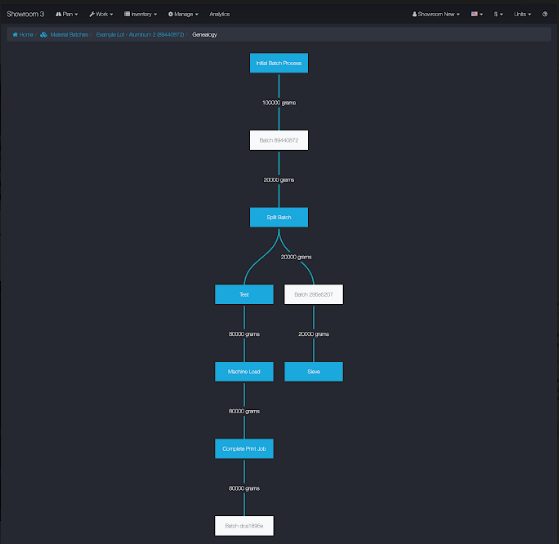Founded in 2012 by Andre Wegner, the goal of the Authentise team has always been to improve manufacturing methods and allow users to leverage the benefits of 3D printing to their maximum capabilities. Now, the firm has announced the release of a “major feature update” in the form of its new Material Management module.
Because issues with materials usage and limited knowledge about how to reuse powders persist, the Authentise team expects its new feature to positively impact the 3D printing industry. With simple tools for tracking powder—along with learning how to blend, test, and more—users have increased access to information, along with machine data, test data, and basic manual operator inputs.
“Digital Material Management is the missing piece of the puzzle for us,” said Miguel Zavala, Project Leader in Laser Additive Manufacturing at TWI Ltd. in the UK. “As a certified Lloyds Register lab, we have to prove that we’re following the right process at all times. The combination of AMES with a seamless material tracking tool delivers a full digital traceability of not only what we’ve done but everything that has happened to the part. We can use that data to improve our processes, provide automated reports to clients and work with our partners to develop better machines, materials, processes and designs.”
With Materials Management, Authentise claims that current customers are able to track actions “to enable a full digital thread of the material,” from sieving to blending, testing, and 3D printing. This also means compatibility with the Authentise Manufacturing Execution System (AMES), including a traceability report with any part. Reporting data includes operator actions, machine data, and full material history.
“We’re excited to be the only independent provider with an end-to-end digital material and part traceability solution,” says Andre Wegner, CEO of Authentise. “There’s still so much we don’t know about the additive process: How do storage conditions affect end part quality? How many times can we recycle, under what conditions? As a result, too much money is wasted as we default to the most secure and expensive options. Too many parts still end up being printed with virgin powder unnecessarily. The integration of our unique ability to draw together data from machines, operators, testing and now materials finally gives us the tools to understand these processes fully, and explain them to our partners.”
The module relies on information gathered from the Material Types, Printer Types, and Printer inventory machines that users manage via Authentise Manufacturing Execution System (AMES). The Authentise QR Scanner mobile app is necessary to link printers in a fleet to the cloud software. With a printed QR code affixed to various machines in a business’s fleet, it’s possible to scan the printer and get material updates on the fly.
 Users can now check the Material Lots and Material Batches of their systems, with Material Lots signifying longer-term inventory items that may be stored in a warehouse and Batches representing material that is on the shop floor already. With QR codes also printed and affixed to material being loaded into the warehouse or onto the factory floor, it’s now possible to track those materials as they move throughout one’s manufacturing operations. As mentioned, this includes everything: “receiving, storage, initial use, reclamation of unused material, and all of the actions in between.”
Users can now check the Material Lots and Material Batches of their systems, with Material Lots signifying longer-term inventory items that may be stored in a warehouse and Batches representing material that is on the shop floor already. With QR codes also printed and affixed to material being loaded into the warehouse or onto the factory floor, it’s now possible to track those materials as they move throughout one’s manufacturing operations. As mentioned, this includes everything: “receiving, storage, initial use, reclamation of unused material, and all of the actions in between.”
Authentise has continued to enhance tools for its customers, paving the way for greater efficiency, quality, and affordability in 3D printing. This includes recent collaborations with companies like Addiguru too, combining artificial intelligence with workflow software.
[Source / Images: Authentise]Subscribe to Our Email Newsletter
Stay up-to-date on all the latest news from the 3D printing industry and receive information and offers from third party vendors.
You May Also Like
NSF Awards Kentucky $1M for Advanced Manufacturing
The National Science Foundation has awarded a $1 million grant to the University of Louisville for the Advancing Manufacturing and Building Construction Technologies (NSF AMT) project. This initiative is part...
3D Printing News Briefs, May 11, 2024: 3D Printed Stent, Tower, Sculptures, & More
We’re starting off with medical research in today’s 3D Printing News Briefs, as researchers in Korea used CT images and 3D printing to fabricate an educational simulator for a mastoidectomy....
3D Printing Unpeeled: Wind Turbines, Probiotics and Lenses
TPI Composites, ORNL and Ingersoll Rand are working to make wind turbine tooling segments that can be 18.3 meters long. These elements also include resistive wires that help keep the...
Tethon 3D Releases Cost-effective Bioprinter
Tethon 3D, known for its ceramic-loaded DLP materials, custom resins, and DLP 3D printers, has recently released a bioprinter. Vat polymerization printers like DLP systems have been widely used by...


































